The Towns that Make Italians Proud
 This is Part 7 of a seven part series presenting 28 fascinating and beautiful Ligurian villages of every type - hill towns and castle towns, walled towns and fishing villages. Each of these small towns has qualified for membership in one of two nifty Italian organizations: The Most Beautiful Villages of Italy I Borghi Piu Belli d'Italia - and The Orange Flags Bandiere Arancioni. Read about these initiatives below in More Info.
This is Part 7 of a seven part series presenting 28 fascinating and beautiful Ligurian villages of every type - hill towns and castle towns, walled towns and fishing villages. Each of these small towns has qualified for membership in one of two nifty Italian organizations: The Most Beautiful Villages of Italy I Borghi Piu Belli d'Italia - and The Orange Flags Bandiere Arancioni. Read about these initiatives below in More Info.
You can see all 28 towns on this Google map: Beautiful Villages of Liguria Map and they are listed below as well. They are described from the French border toward La Spezia so you can easily integrate these beautiful towns with visits to San Remo, Portofino, Genoa, or the Cinque Terre.
Each town has a story to tell and some friendly people ready to tell it. While you can't tour them all, just visiting a few will add an authentic Italian flavor to your trip to Liguria. If you want to get off the beaten path in Italy, these villages will do it. Please subscribe on the right to receive future installments of The Most Beautiful Villages in Liguria. For information about visiting Liguria in spring, see our story Spring Weather in Liguria.
For other interesting villages in Liguria, read our new article: Great Italian Hill Towns near Cinque Terre
Pignone
What hiker in Cinque Terre hasn't wished that they could 'get off the beaten track'? What tourist, hemmed in by the crowds drawn to beautiful Vernazza, wouldn't love to explore an uncrowded and pretty Italian town? Little do they realize undiscovered, proud Pignone is just 6 kilometers away as the magpie flies. An evocative, historic town - Vernazza and Monterosso were once suburbs - where the residents greet a visitor with a smile and a bit of surprise, and the history is deep and all surrounding. A town recently awarded the Bandiera Arancione by the Touring Club Italiano.
The history of Pignone is all about its location. Since ancient times, the town has been on trade routes between larger towns. To the Romans, it was on the route between the coast and the cities of Luni to the south and Velleia to the east. In Medieval times, it was on the route between Sestri Levante and Sarzana or the Emilia plain via Varese Ligure. These trade opportunities, combined with its fertile farmland and a location away from the dangers of the coast, allowed the little city a modest prosperity for centuries.
Modest prosperity only, for Pignone doesn't flaunt a wealthy past. The unadorned buildings suggest an economic struggle in the last few centuries, but that has also provided preservation. Walking the stone covered streets past grey and ancient stone buildings will make you imagine your ancestor's lives.
Dominating the skyline of the town is the steeple of the parochial Church of Santa Maria Assunta. The origins were a paleo-Romanesque church from 1,000 and it was rebuilt in 1339 and then it was re-rebuilt in the 1700's. As you explore, imagine the stir created by the biggest event in town history. In 1312, the Holy Roman Emperor Enrico VII of Luxembourg visited with a retinue that included homeboy Cardinal Fieschi and 1500 soldiers - well more than the town's population. At the time there was a Fieschi Castello near the medieval entry gate, but little remains now.
The open center of the town is beautiful. It dates from the 1500's when the surrounding signorial palazzi were built, along with new passageways and defensive works. In the 1700's the Loggia you see was constructed, we imagine as a nod to the communal stirrings of the era. We'd like to direct you to the Bridge of the Madonnina. Instead we found a photo - the bridge was destroyed in the flood of Oct. 2011. Ironically the town cherished the bridge because the Madonna had miraculously survived a flood a couple of centuries before.
The town's pride was not damaged, though, and it celebrates at a large festival in late August: Gli Orti di Pignone (The Gardens of Pignone). Read about the food specialties including fabulous potatoes in our story: Food Is History in Liguria
Up on a hill nearby is the hamlet of Casale where there are two restaurants and the Church of San Martino and an old neighborhood has been nicely restored as vacation housing. There are remains of a castle made into a park which seemed picnic friendly.
In Pignone is the restaurant and small hotel 'Locanda da Marco' on Via del Campanile, 139. Tel. 0187-887950. Website: Locanda da Marco. The place seemed clean and friendly when we stopped by.
There are several hiking trails available between the Cinque Terre, Pignone, and Casale covered by the better Cinque Terre hiking maps. The town website has some tourist information, including Italian descriptions of some trails. Comune Pignone.
Vernazza
Since the whole world agrees with us that Vernazza is beautiful, there is no need for us to write about it. We will just urge you to learn about Vernazza and the Cinque Terre from several realistic sources before you go. The popularity of these villages can create disappointment for the unprepared.
Go to Vernazza because it uniquely offers the sights and experiences that suit your preferences, not because it's on a bucket list, or because yet another travel writer wrote it up. Italy and Liguria offer many other wonderful choices, it just takes some research.
Tellaro
And here we are finally to Tellaro, “a nirvana between sea and sky, between the rocks and the green mountain.” Mario Soldati
Tellaro is simply magical. Even its history has elements of amazing, unknowable, astonishing magic. The most famous historical tale is that of a dark and stormy night in 1660, when a fleet of six pirate ships crept through the fog to attack the village. The watchman, Marco Arzellino, had tied the bell rope to his foot, and at just the moment the pirates came close enough to land, the bells rang out, alerting the townspeople and saving everyone. Some at the time thought that Marco had luckily twitched in his sleep, others swore that a giant octopus had emerged from the sea and rung the bell for Marco. They still eat a lot of octopus in the area. On the second Sunday in August Tellaro holds the Sagra di Polpo (octopus festival) with their favorite two dishes, octopus "Tellaro-style" (boiled and then chopped and mixed with cooked potatoes, olives, tomatoes, onions, parsley and oil) or octopus "Inferno-style" (stewed with bay leaves, marjoram, chilies, tomatoes and some white wine.)
Today Tellaro is magical in its ambiance, in its ancient and colorful houses facing the sea in layers, in the shaded Ligurian lanes called caruggi. The village is actually part of Lerici, but has its own very unique character. For one thing, getting there can be an adventure in itself. It’s on a peninsula, reached by a narrow and curvy dead-end road, with insufficient parking in summer. You can drive in to a certain point, park, and walk; you can park in Lerici and take a cab (about 15 E); or you can take a bus from Lerici. Walking the road would be fine, but there are no sidewalks or direct trails, so it could definitely scare the imaginative. You can also park & hike: drive along the road circling the Caprione peninsula from Lerici towards Montemarcello, park at Zanego (a/k/a Four Corners) and walk down the marked trail. It’s a beautiful walk with fabulous views, but you do have to climb back up! (The walk is described in the last part of our story The Bride's Walk - Ameglia to Tellaro)
When you’re in the town, you can’t go wrong, head down to the sea. The passageways are far too narrow for cars, you just follow the brick walks and very soon you’re at the ocean. There’s a ramp where the fishing boats are pulled up at night, with a shallow splash area for kids to enjoy and pick up the little bits of colored tile smoothed by the tides. Boats are stored here and there. Opposite are rocks where waves make a spectacle during a mareggiata (sea storm) and walkways where ladies inspire bloggers on sunny days (Topless in Tellaro).
There are fabulous views of the sea, the coast, the islands, and the Portovenere Promontory. Walking just a little farther, you round the end of the town, and there are shady places to sit and watch the waves and the rocks and the sunset. As you explore more, you’ll find an old square, and a tiny old 500-year San Giorgio church, and before you know it, you recognize the way you came in.
Tellaro's literary links are explored in the town's page on Borghi Piu Belli.
There is a wonderful gastronomia - Leandro - with groceries, fruit, wine, bread and some of the best pesto you’ll ever taste – artisanal of course - where the stairs approach the piazza. There are a few well-regarded restaurants in Tellaro, mostly on the road into town. Here's our annotated Restaurants and Overview Map of the Caprione Promontory with some restaurant ideas.
Travel Tip
Where to Stay in Cinque Terre?
_________________________________________________________________________________
Use the ferry to avoid the crowds while you enjoy the Gulf of the Poets towns. Read our descriptions and hotel recommendations:
Link: Guide to Portovenere Lerici La Spezia
_________________________________________________________________________________
Montemarcello
We are not unbiased when it comes to Montemarcello, just so you know. Let's start where the light hits the water, at the punto panoramico. Across the street from the Il Giordino bar/cafe on the sea side of town, follow the brick sidewalk - the only turn is a left at the fork. The path will end at a cliff-top overlooking the Gulf of La Spezia. The view is immense and before you is the island of Palmaria and the Portovenere promontory. Below you are the dark sands of the famous beach at Punta Corvo. Big ships wait for berths, sailboats and fishing boats meander, and if you're lucky, the island of Gorgona lurks in the distance. It's a good place to talk or think or smooch or watch for the enemy. True. Before it was a paradise, Montemarcello was a military post.
The village began as a Roman castra (military camp) to protect the nearby city of Luni which was then the frontier. The layout of Montemarcello – long parallel streets, smaller cross lanes, streets leading to the commander's praetorium, a surrounding wall – all were prescribed by Roman military tradition. The town's name is Roman too, named after Marcus Claudius Marcellus, the Consul who defeated the Apuani in 155 BC. The views of the Apuan Alps were the chief military advantage – from here you can see Luni and a ring of least five other Roman military sites. The military use of the area continued after the Romans, an ancient watchtower survives probably from medieval times, cannon emplacements were added in the Napoleonic era, and that use continued through WWII.*
It's the feel and the charm of the place that is incomparable. We often enter the town from the Ameglia side near the excellent Trattoria dai Pironcello, a former olive mill. Passing the gate nearby, the quiet shaded streets will calm you like an armchair. You'll find yourself walking slowly and softly - the diffused light and the Ligurian colors lending themselves to your photos.
There's a changeless feeling, and for good reason – it hasn't. The old part looks just like it did in the adjacent map by Vinzoni circa 1770 - except for one sad difference. At the center of the village there is now Piazza XIII Dicembre, occupied by buildings on Vinzoni's map. In this place on Dec. 13 1944, an allied bomb landed during an attack on a anti-aircraft emplacement 400 meters away. It killed 35 residents - the remains of four were never recovered.** Seventy years later, still there are fresh flowers placed here often.
The only monument in town is the parochial Church of San Pietro from around 1474. It's large for a town this small, and the pleasant Ligurian pink exterior has been recently renewed. Inside the art works of note are a 1529 marble alterpiece on the left wall by Domenico Gar, and in the first chapel on the left, a enigmatic three panel 14th century painting of the Virgin between Peter and John the Baptist.
This entire area is in the large Parco di Montemarcello Magra, with numerous well-marked hiking trails - some along cliffs, some through olive groves and Mediterranean landscapes – all free of fee and people. The trails are the very much the equal of the more famous and more crowded trails nearby favored by lazy travel writers. The website Parco Magra has some descriptions in Italian but does not have useful hiking maps. However they have erected large signs with trail schematics at key points around the peninsula.
We recommend a map sold in local kiosks Bassa Magra Map 141 by 4Land (click to see) - it is recent and has all the CAI trails.
Gardeners and fellow plant lovers please note, the Park also has an interesting Botanical Garden nearby with an English website Orto Botanico which can help you appreciate the unique Mediterranean environment of this area. There are guided tours on some weekends and holidays.
Here's an easy one hour walk we like. Leave Montemarcello on the downhill paved road toward Ameglia. Walk pass the cemetery to enjoy the views of the Alps. Backtrack and across from the cemetery, follow the marked trail down into the forest opposite. After less than a kilometer you'll reach the paved road, turn left and follow it uphill back to Montemarcello.
Montemarcello is well located but accommodations are limited**. The Trattoria dai Pironcello operates a three unit Bed & Breakfast reachable at pironcelli@alice.it. In the village center, the Bed and Breakfast Sotto Le Mura has one unit - contact 331-5246802 or pietro pelizzi@yahoo.it. A larger facility with 27 rooms, restaurant, and spa has opened recently near the punto panoramico: Golfo dei Poeti Relais & Spa.
We have an annotated Restaurants and Overview Map of the Caprione Promontory with some attractions and restaurant ideas.
* In 1944-45, the batteries of large cannon on this promontory stopped the Allied advance, led by the 92nd African-American infantry division with attached units of Japanese-American soldiers. Read about these heroes: Liberation Day and the Liberation of America.
** Thanks to Laura Rigo at the local website Montemarcello for help with information on the December 1944 bombing and available accommodations.
Castelnuovo Magra
Castelnuovo Magra is a gem. The town is stretched out on the top of Monte Bastione, one of the lovely foothills of the Apuan Alps, with the picturesquely ruined castle, Palazzo Vescovile, on one end to a lovely church, L’Oratorio dei Bianchi on the other. You can see the town in its majestic setting from everywhere along the coast, often catching the sunset light on its crenelated tower.
The main street runs the length of town, narrow and cobbled of course, and not open to traffic. Along the street are mansions from the seventeenth and eighteenth centuries: the home of Ingolotti Cornelius, Tonarelli palace and palace Ferrari-Natolini. The parish church is really remarkable, especially for a small town. St. Mary Magdalene dates from the late Renaissance, and was built in the seventeenth century on the foundations of a much earlier building. The church has three naves, divided by twelve columns of white Carrara marble. In the first chapel on the left, there's a scene of Calvary attributed to Peter Bruegel the Younger. In the second altar on the left is an 18th century painting dedicated to the patron saint of Castelnuovo Magra , San Fedele, the background of which shows a view of eighteenth-century Castelnuovo Magra. For good measure, there’s a Madonna by Fiasella Domenico (1589-1669) and a Crucifixion attributed to Van Dyck.
The Palazzo Vescovile is no slouch either. It was built in the 12th century to control and protect the Via Francigena. And it was here, on October 6, 1306, that Dante Alighieri, in his capacity as attorney of the Marquis Malaspina Franceschino Mulazzo, signed a peace treaty with the Bishop/Count of Luni, Anthony of Camilla, which put an end (sort of) to the struggle between the bishops and the Malaspina family. Imposing ruins remain: a very large battlemented tower, a smaller circular tower, and a crenelated wall loom over a little playground for children.
Since this is Italy, Castelnuovo Magra is known for local specialty food products. Easiest to find are the DOC wines Colli di Luni - the white Vermentino is excellent. There's also olive oil and, best of all, Prosciutta castelnovese. This is a form of ham that’s very delicate, both in smell and taste, and is produced by Mirco Bertini from a traditional recipe. The meat is boned, and the leanest section is used. It is salted, carefully seasoned by massaging it with a secret herb mixture, then aged at least 7 months. You can buy it at Antica Salumeria Elena & Mirco in via Canale 52, in the flat part of town where they also sell other specialty meats such as spiced pancetta and lardo sausage. The website: Antica Salumeria.
Castelnuovo Magra is also home to the well respected Trattoria Armanda, a tiny restaurant serving terrific traditional Ligurian food. Reservations are necessary, there are sample menu items and contact info on their website: Trattoria Armanda Phone: 0187-674410.
Information in Italian about the town with excellent photos are in a fantastic online brochure Comune Castelnuovo Magra. It includes a map and lists of local winemakers, lodging, etc.
More Info.
Itinerary Map - Create your Ligurian itinerary: Beautiful Villages of Liguria Map
New Story Link: Great Italian Hill Towns near Cinque Terre
I Borghi Piu Belli d'Italia - The Most Beautiful Villages of Italy - is an independent association of 206 Italian towns that meet criteria of architectural integrity, quality of life, as well as artistic and historical heritage. The borghi have joint promotions, joint festivals, and a guide book. The website I Borghi Piu Belli d'Italia has nice English descriptions of each of the localities making it a useful tool for planning travel to other parts of Italy. Eighteen of the villages wait for you in Liguria.
Bandiere Arancioni - The Orange Flags - is an initiative of Touring Club Italiano to identify localities of excellence in Italy. These Italian towns must pass numerous tourist-oriented criteria related to welcome, attractions, services, structure, and environment. The website Best Small Towns Italy provides information about each town and the process in English, and in Italian Bandiere Arancioni tells all. Thirteen towns in Liguria have been awarded the Bandiera Arancione.
Written by Martha
Index to The Most Beautiful Villages in Liguria - Click the Part Number. Towns in the seven parts.
Part 1: Ventimiglia / San Remo area:
Airole Dolceacqua Apricale Pigna Seborga
Part 2: Imperia / Alassio area:
Triora Lingueglietta Cervo Laigueglia
Part 3: Albenga area:
Colletta di Castelbianco Castelvecchio di Rocca Barbena Zuccarello Toirano
Part 4: Finale Ligure area:
Borgio Verezzi Finalborgo Noli
Part 5: Savona / Genoa area:
Millesimo Sassello Campo Ligure
Part 6: Rapallo / Levanto area:
Santo Stefano d'Aveto Moneglia Varese Ligure Brugnato
Part 7: Cinque Terre / La Spezia area:
Pignone Vernazza Tellaro Montemarcello Castelnuovo Magra
- Pignone
- Vernazza
- Tellaro
- Montemarcello
- Castelnuovo Magra
 This is Part 7 of a seven part series presenting 28 fascinating and beautiful Ligurian villages of every type - hill towns and castle towns, walled towns and fishing villages. Each of these small towns has qualified for membership in one of two nifty Italian organizations: The Most Beautiful Villages of Italy I Borghi Piu Belli d'Italia - and The Orange Flags Bandiere Arancioni. Read about these initiatives below in More Info.
This is Part 7 of a seven part series presenting 28 fascinating and beautiful Ligurian villages of every type - hill towns and castle towns, walled towns and fishing villages. Each of these small towns has qualified for membership in one of two nifty Italian organizations: The Most Beautiful Villages of Italy I Borghi Piu Belli d'Italia - and The Orange Flags Bandiere Arancioni. Read about these initiatives below in More Info.You can see all 28 towns on this Google map: Beautiful Villages of Liguria Map and they are listed below as well. They are described from the French border toward La Spezia so you can easily integrate these beautiful towns with visits to San Remo, Portofino, Genoa, or the Cinque Terre.
Each town has a story to tell and some friendly people ready to tell it. While you can't tour them all, just visiting a few will add an authentic Italian flavor to your trip to Liguria. If you want to get off the beaten path in Italy, these villages will do it. Please subscribe on the right to receive future installments of The Most Beautiful Villages in Liguria. For information about visiting Liguria in spring, see our story Spring Weather in Liguria.
For other interesting villages in Liguria, read our new article: Great Italian Hill Towns near Cinque Terre
Pignone
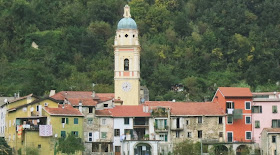 |
Pignone with the steeple of the Church of Santa Maria Assunta.
|
The history of Pignone is all about its location. Since ancient times, the town has been on trade routes between larger towns. To the Romans, it was on the route between the coast and the cities of Luni to the south and Velleia to the east. In Medieval times, it was on the route between Sestri Levante and Sarzana or the Emilia plain via Varese Ligure. These trade opportunities, combined with its fertile farmland and a location away from the dangers of the coast, allowed the little city a modest prosperity for centuries.
Modest prosperity only, for Pignone doesn't flaunt a wealthy past. The unadorned buildings suggest an economic struggle in the last few centuries, but that has also provided preservation. Walking the stone covered streets past grey and ancient stone buildings will make you imagine your ancestor's lives.
Dominating the skyline of the town is the steeple of the parochial Church of Santa Maria Assunta. The origins were a paleo-Romanesque church from 1,000 and it was rebuilt in 1339 and then it was re-rebuilt in the 1700's. As you explore, imagine the stir created by the biggest event in town history. In 1312, the Holy Roman Emperor Enrico VII of Luxembourg visited with a retinue that included homeboy Cardinal Fieschi and 1500 soldiers - well more than the town's population. At the time there was a Fieschi Castello near the medieval entry gate, but little remains now.
 |
| Ponte della Madonnina Destroyed Oct. 11, 2011 |
The town's pride was not damaged, though, and it celebrates at a large festival in late August: Gli Orti di Pignone (The Gardens of Pignone). Read about the food specialties including fabulous potatoes in our story: Food Is History in Liguria
Up on a hill nearby is the hamlet of Casale where there are two restaurants and the Church of San Martino and an old neighborhood has been nicely restored as vacation housing. There are remains of a castle made into a park which seemed picnic friendly.
In Pignone is the restaurant and small hotel 'Locanda da Marco' on Via del Campanile, 139. Tel. 0187-887950. Website: Locanda da Marco. The place seemed clean and friendly when we stopped by.
There are several hiking trails available between the Cinque Terre, Pignone, and Casale covered by the better Cinque Terre hiking maps. The town website has some tourist information, including Italian descriptions of some trails. Comune Pignone.
Travel Tip___________________________________________________________________
Renting A Car in Italy. If you drive in urban areas at home, you can drive in Italy. Car rental prices are important, but don't rent solely on low price and stick to well known companies. We have articles to help you:
Link: Independent Car Rental Reviews for Italy
Link:Car Rental Tips for Italy - Pick It Up Right
Link: Where to Rent a Car from Cinque Terre? Also useful for the Portofino area.
We advise getting your car from one of the companies with the fewest problems reported (Avis, Europcar, Hertz, Autovia, Budget) either direct or via a reputable car rental broker such as AutoEurope (NOT autoeuropa, ending in 'a'). The advantages of using AutoEurope are the added services without paying more - low price guarantee; 24/7 help before, during, and after the rental; easy changes and cancellation; as well as available less expensive zero excess (deductible) insurance.** If you find our efforts helpful, you can thank us by making your reservation through these links -using the links do not raise your price.
AutoEurope(US) Auto Europe(UK) Avis(English) Avis(IT)
Budget Rental (Europe in English) Budget Rental (in Italian)
_________________________________________________________________________________
Link: Independent Car Rental Reviews for Italy
Link:Car Rental Tips for Italy - Pick It Up Right
Link: Where to Rent a Car from Cinque Terre? Also useful for the Portofino area.
We advise getting your car from one of the companies with the fewest problems reported (Avis, Europcar, Hertz, Autovia, Budget) either direct or via a reputable car rental broker such as AutoEurope (NOT autoeuropa, ending in 'a'). The advantages of using AutoEurope are the added services without paying more - low price guarantee; 24/7 help before, during, and after the rental; easy changes and cancellation; as well as available less expensive zero excess (deductible) insurance.** If you find our efforts helpful, you can thank us by making your reservation through these links -using the links do not raise your price.
AutoEurope(US) Auto Europe(UK) Avis(English) Avis(IT)
Budget Rental (Europe in English) Budget Rental (in Italian)
_________________________________________________________________________________
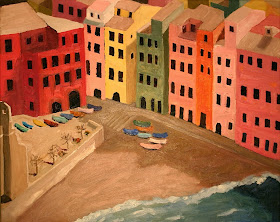 |
| Vernazza 'My Third Oil Painting' Go Matt Olson |
Go to Vernazza because it uniquely offers the sights and experiences that suit your preferences, not because it's on a bucket list, or because yet another travel writer wrote it up. Italy and Liguria offer many other wonderful choices, it just takes some research.
Tellaro
And here we are finally to Tellaro, “a nirvana between sea and sky, between the rocks and the green mountain.” Mario Soldati
 |
| A Tellaro Door |
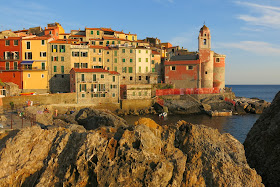 |
| Tellaro in evening light. People sunbathe on those rocks! fotosciac |
 |
| Tellaro amalaspezia.eu |
When you’re in the town, you can’t go wrong, head down to the sea. The passageways are far too narrow for cars, you just follow the brick walks and very soon you’re at the ocean. There’s a ramp where the fishing boats are pulled up at night, with a shallow splash area for kids to enjoy and pick up the little bits of colored tile smoothed by the tides. Boats are stored here and there. Opposite are rocks where waves make a spectacle during a mareggiata (sea storm) and walkways where ladies inspire bloggers on sunny days (Topless in Tellaro).
There are fabulous views of the sea, the coast, the islands, and the Portovenere Promontory. Walking just a little farther, you round the end of the town, and there are shady places to sit and watch the waves and the rocks and the sunset. As you explore more, you’ll find an old square, and a tiny old 500-year San Giorgio church, and before you know it, you recognize the way you came in.
Tellaro's literary links are explored in the town's page on Borghi Piu Belli.
There is a wonderful gastronomia - Leandro - with groceries, fruit, wine, bread and some of the best pesto you’ll ever taste – artisanal of course - where the stairs approach the piazza. There are a few well-regarded restaurants in Tellaro, mostly on the road into town. Here's our annotated Restaurants and Overview Map of the Caprione Promontory with some restaurant ideas.
Travel Tip
Where to Stay in Cinque Terre?
_________________________________________________________________________________
Use the ferry to avoid the crowds while you enjoy the Gulf of the Poets towns. Read our descriptions and hotel recommendations:
Link: Guide to Portovenere Lerici La Spezia
_________________________________________________________________________________
Montemarcello
We are not unbiased when it comes to Montemarcello, just so you know. Let's start where the light hits the water, at the punto panoramico. Across the street from the Il Giordino bar/cafe on the sea side of town, follow the brick sidewalk - the only turn is a left at the fork. The path will end at a cliff-top overlooking the Gulf of La Spezia. The view is immense and before you is the island of Palmaria and the Portovenere promontory. Below you are the dark sands of the famous beach at Punta Corvo. Big ships wait for berths, sailboats and fishing boats meander, and if you're lucky, the island of Gorgona lurks in the distance. It's a good place to talk or think or smooch or watch for the enemy. True. Before it was a paradise, Montemarcello was a military post.
 |
| The Watchtower. |
The village began as a Roman castra (military camp) to protect the nearby city of Luni which was then the frontier. The layout of Montemarcello – long parallel streets, smaller cross lanes, streets leading to the commander's praetorium, a surrounding wall – all were prescribed by Roman military tradition. The town's name is Roman too, named after Marcus Claudius Marcellus, the Consul who defeated the Apuani in 155 BC. The views of the Apuan Alps were the chief military advantage – from here you can see Luni and a ring of least five other Roman military sites. The military use of the area continued after the Romans, an ancient watchtower survives probably from medieval times, cannon emplacements were added in the Napoleonic era, and that use continued through WWII.*
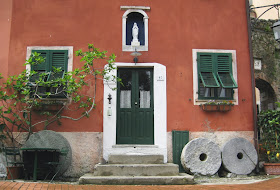 |
| Trattoria dai Pironcello in an ancient olive mill. Montemarcello, Liguria. |
It's the feel and the charm of the place that is incomparable. We often enter the town from the Ameglia side near the excellent Trattoria dai Pironcello, a former olive mill. Passing the gate nearby, the quiet shaded streets will calm you like an armchair. You'll find yourself walking slowly and softly - the diffused light and the Ligurian colors lending themselves to your photos.
 |
| Montemarcello, c.1770. |
There's a changeless feeling, and for good reason – it hasn't. The old part looks just like it did in the adjacent map by Vinzoni circa 1770 - except for one sad difference. At the center of the village there is now Piazza XIII Dicembre, occupied by buildings on Vinzoni's map. In this place on Dec. 13 1944, an allied bomb landed during an attack on a anti-aircraft emplacement 400 meters away. It killed 35 residents - the remains of four were never recovered.** Seventy years later, still there are fresh flowers placed here often.
The only monument in town is the parochial Church of San Pietro from around 1474. It's large for a town this small, and the pleasant Ligurian pink exterior has been recently renewed. Inside the art works of note are a 1529 marble alterpiece on the left wall by Domenico Gar, and in the first chapel on the left, a enigmatic three panel 14th century painting of the Virgin between Peter and John the Baptist.
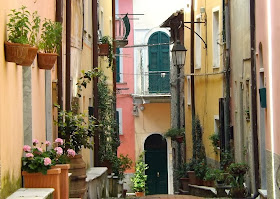 |
| Montemarcello @Girovagate |
We recommend a map sold in local kiosks Bassa Magra Map 141 by 4Land (click to see) - it is recent and has all the CAI trails.
Gardeners and fellow plant lovers please note, the Park also has an interesting Botanical Garden nearby with an English website Orto Botanico which can help you appreciate the unique Mediterranean environment of this area. There are guided tours on some weekends and holidays.
Here's an easy one hour walk we like. Leave Montemarcello on the downhill paved road toward Ameglia. Walk pass the cemetery to enjoy the views of the Alps. Backtrack and across from the cemetery, follow the marked trail down into the forest opposite. After less than a kilometer you'll reach the paved road, turn left and follow it uphill back to Montemarcello.
Montemarcello is well located but accommodations are limited**. The Trattoria dai Pironcello operates a three unit Bed & Breakfast reachable at pironcelli@alice.it. In the village center, the Bed and Breakfast Sotto Le Mura has one unit - contact 331-5246802 or pietro pelizzi@yahoo.it. A larger facility with 27 rooms, restaurant, and spa has opened recently near the punto panoramico: Golfo dei Poeti Relais & Spa.
We have an annotated Restaurants and Overview Map of the Caprione Promontory with some attractions and restaurant ideas.
* In 1944-45, the batteries of large cannon on this promontory stopped the Allied advance, led by the 92nd African-American infantry division with attached units of Japanese-American soldiers. Read about these heroes: Liberation Day and the Liberation of America.
** Thanks to Laura Rigo at the local website Montemarcello for help with information on the December 1944 bombing and available accommodations.
Castelnuovo Magra
Castelnuovo Magra is a gem. The town is stretched out on the top of Monte Bastione, one of the lovely foothills of the Apuan Alps, with the picturesquely ruined castle, Palazzo Vescovile, on one end to a lovely church, L’Oratorio dei Bianchi on the other. You can see the town in its majestic setting from everywhere along the coast, often catching the sunset light on its crenelated tower.
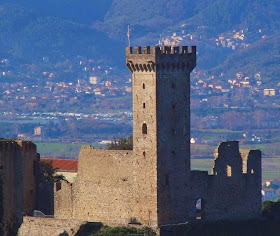 |
| The ruins of the Palazzo Vescovile at Castelnuovo Magra. amalaspezia.eu |
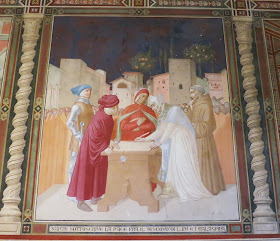 |
| Dante & the Bishop of Luni signing. Fosdinovo Castle. |
The Palazzo Vescovile is no slouch either. It was built in the 12th century to control and protect the Via Francigena. And it was here, on October 6, 1306, that Dante Alighieri, in his capacity as attorney of the Marquis Malaspina Franceschino Mulazzo, signed a peace treaty with the Bishop/Count of Luni, Anthony of Camilla, which put an end (sort of) to the struggle between the bishops and the Malaspina family. Imposing ruins remain: a very large battlemented tower, a smaller circular tower, and a crenelated wall loom over a little playground for children.
Since this is Italy, Castelnuovo Magra is known for local specialty food products. Easiest to find are the DOC wines Colli di Luni - the white Vermentino is excellent. There's also olive oil and, best of all, Prosciutta castelnovese. This is a form of ham that’s very delicate, both in smell and taste, and is produced by Mirco Bertini from a traditional recipe. The meat is boned, and the leanest section is used. It is salted, carefully seasoned by massaging it with a secret herb mixture, then aged at least 7 months. You can buy it at Antica Salumeria Elena & Mirco in via Canale 52, in the flat part of town where they also sell other specialty meats such as spiced pancetta and lardo sausage. The website: Antica Salumeria.
Castelnuovo Magra is also home to the well respected Trattoria Armanda, a tiny restaurant serving terrific traditional Ligurian food. Reservations are necessary, there are sample menu items and contact info on their website: Trattoria Armanda Phone: 0187-674410.
Information in Italian about the town with excellent photos are in a fantastic online brochure Comune Castelnuovo Magra. It includes a map and lists of local winemakers, lodging, etc.
More Info.
Itinerary Map - Create your Ligurian itinerary: Beautiful Villages of Liguria Map
New Story Link: Great Italian Hill Towns near Cinque Terre
I Borghi Piu Belli d'Italia - The Most Beautiful Villages of Italy - is an independent association of 206 Italian towns that meet criteria of architectural integrity, quality of life, as well as artistic and historical heritage. The borghi have joint promotions, joint festivals, and a guide book. The website I Borghi Piu Belli d'Italia has nice English descriptions of each of the localities making it a useful tool for planning travel to other parts of Italy. Eighteen of the villages wait for you in Liguria.
Bandiere Arancioni - The Orange Flags - is an initiative of Touring Club Italiano to identify localities of excellence in Italy. These Italian towns must pass numerous tourist-oriented criteria related to welcome, attractions, services, structure, and environment. The website Best Small Towns Italy provides information about each town and the process in English, and in Italian Bandiere Arancioni tells all. Thirteen towns in Liguria have been awarded the Bandiera Arancione.
Written by Martha
Index to The Most Beautiful Villages in Liguria - Click the Part Number. Towns in the seven parts.
Part 1: Ventimiglia / San Remo area:
Airole Dolceacqua Apricale Pigna Seborga
Part 2: Imperia / Alassio area:
Triora Lingueglietta Cervo Laigueglia
Part 3: Albenga area:
Colletta di Castelbianco Castelvecchio di Rocca Barbena Zuccarello Toirano
Borgio Verezzi Finalborgo Noli
Part 5: Savona / Genoa area:
Millesimo Sassello Campo Ligure
Part 6: Rapallo / Levanto area:
Santo Stefano d'Aveto Moneglia Varese Ligure Brugnato
Part 7: Cinque Terre / La Spezia area:
Pignone Vernazza Tellaro Montemarcello Castelnuovo Magra
